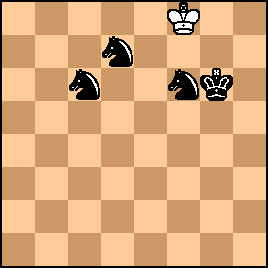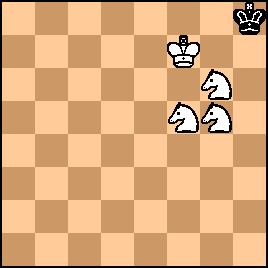|
Beginners should know that the mate by two Knights requires a Pawn on the other side and that the mate by three Knights is possible on their own. They must not be so quick to offer a draw with these piece groups. They can win! Further, IM Reuben Fine described the Three-Knight Mate as one of the Elementary Mates in the first chapter of his tome, Basic Chess Endings (BCE, pp. 5-6). This game collection is meant to bolster that information, i.e., to dispel the misconception that Knights are too weak to mate on their own. I wonder how widespread that unwarranted matter has become. As a case in point, a commentator on Chess.com answered a query whether three Knights could mate by giving an extract from one of his own games, starting here: 
click for larger viewHe was not a strong player, so his line to mate was not optimal. However, Stockfish 17 gives this M9 line:
1.... Kf5 2.Kg7 Ne5 3.Kf8 Kf6 4.Ke8 N7c6 5.Kf8 Nd2 6.Ke8 Kg6 7.Kf8 Ne4 8.Ke8 Nf6+ 9.Kf8 Ned7#

click for larger viewI use 'Lonely' in the title of this game collection to indicate that the other King is all by itself, being pursued by Knights and a King. No other helpers are involved. (A pair of blockaded Pawns is not really significant, so a game here may have them on board.) The lone King position should be taken as the starting point for this endgame, but in some cases the last Promotion occurs afterwards. I use this to mean that the defending King has no team members and no Pawns are on the board at all. The players just have the five chessmen-- two Kings and three Knights. The counting for the 50-Move Rule starts there. It is of interest to note that any lone King position can only be reached by a capture made by the attacking chessmen. This factoid makes it easy to peruse the game score and locate the lone King position, as it will be the last capture for the given side for the given game. Further, it means that the continuation will always begin with a move by the defending King, then with the attacking side to bring the mate eventually. The continuation, then, will either be Black to play and White to win or White to play and Black to win. No other possibility is available. IM Fine declared that the Three-Knight mate should be accomplished in 20 moves or less. In 2018/2019, researchers in Germany published their research, proving by retrograde analysis that three Knights can only force checkmate on the edge of the board. Their proposition includes the corners, as the conclusion of a study from IM Fine demonstrates:

click for larger viewIn fact, all of the studies presented by IM Fine give the mate in the corner. This game collection is primarily intended for highly-motivated beginners. Although IM Fine had stressed its importance, it rarely occurs over-the-board (OTB), so I would not make learning the Three-Knight Mate a high priority. However, I do maintain that several benefits will accrue from reviewing the Three-Knight Mate process and these games enable that minimal effort. A determined student will gain from observing the details of the process, noticing certain patterns that appear, whether the King must just cover escape squares or protect the Knights as well (or neither action), visualization (especially of reach and space), coordination of the pieces and other factors. This position for mate shows where the King really could be far away, as it redundantly covers an escape square, only:

click for larger viewThe notation <Qn> is for identifying quadrants of the chessboard, clockwise from upper right. So, Q3 is the third quadrant. ChessCoachClark (CCC) originated this game collection in July of 2022 and he updates it on occasion. This project is a work in progress, culling games from various sources, including several chess training books and personal research. The games are ordered by date (oldest first), not by importance. Be well.
Be safe.
| 


